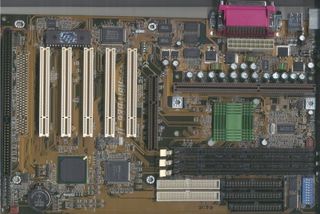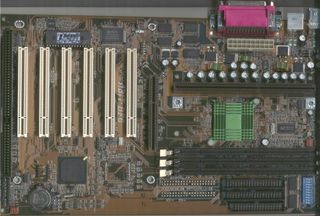The Best For Freaks: 10 Motherboards using the BX-Chipset
ABit BE6-II And BF6

Board Revision: D
BIOS Version: 8. Mai 2000

Board Revision: B4
BIOS Version: 8. Mai 2000
Back in April we used the BE6-II for our tests at 150 MHz bus speed . Both the BF6 and BE6-II are Slot-1 models. If you want to use a Celeron processor, you will have to purchase a Socket 370 to Slot-1 adapter board. Both boards do not attract attention very much, as the only special feature is the IDE controller chip from HighPoint (HPT366), which can only be found on the BE6-II. And that's already the difference between those two boards. Same design and same features - except the 2nd IDE controller. Thanks to it, you may run up to eight IDE devices with the BE6-II. 150 MHz system speed turned out to be a little bit too much for the HighPoint chip, as the system crashed twice during the tests (only when using the UltraDMA/66 coltroller!). Using the PIIX4 integrated IDE controller did not cause any problems.
Both manuals are quite comprehensive. In the package, you will also find a temperature probe which can be used to survey the temperature of the graphics card, for example. The BE6-II does also include a ATA66 IDE cable.
All CPU settings can be done easily in ABit's Soft Menu III, which also allows the adjustment of the CPU voltage and the PCI/AGP dividers. The system bus speed can be chosen in single MHz-increments between 83 and 200 MHz, whilst all settings beyond 155 MHz don't make much sense any more. Below 83 MHz, you may also set 75 and 66 MHz, of course. Giving the customer the option to set the system speed in little increments is the best basis for Celeron overclocking. Only few models run stable at 100 MHz FSB (instead of default 66 MHz), so it's important to have as much options as possible between 83 and 100 MHz. This way it is easiest to run the Celeron at its fastest and still safe clock speed; you will only need to play around some time with the settings.
Stay on the Cutting Edge
Join the experts who read Tom's Hardware for the inside track on enthusiast PC tech news — and have for over 25 years. We'll send breaking news and in-depth reviews of CPUs, GPUs, AI, maker hardware and more straight to your inbox.
There were no surprises regarding the benchmarks, as all results are just how we expected them to be. Thanks to the options to change the PCI and AGP dividers, the ABit boards still belongs to the very best overclocker boards. Different to the Asus CUBX, we had no problems running our Celeron 566 at 850 MHz (100 MHz FSB and 1.65V).
Most Popular

